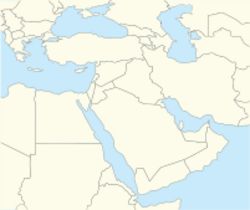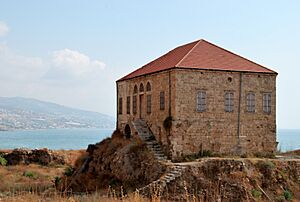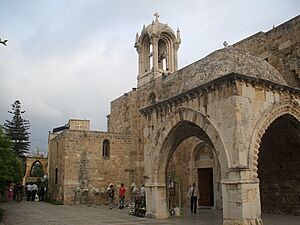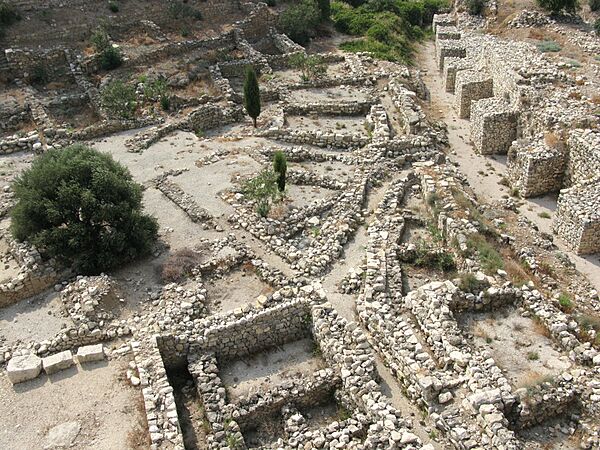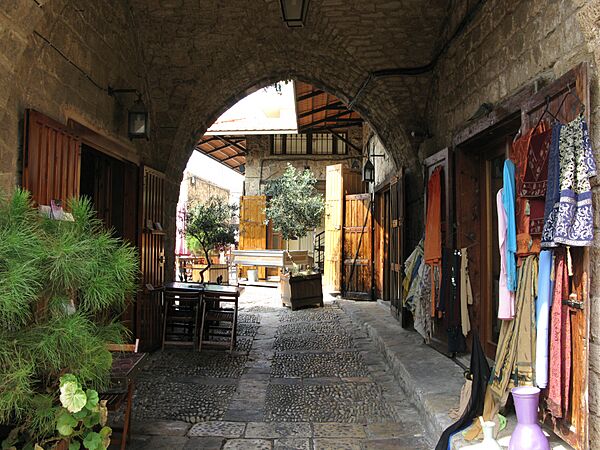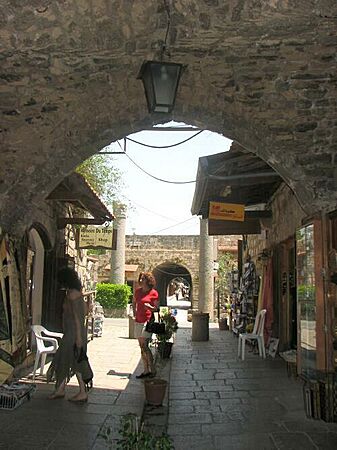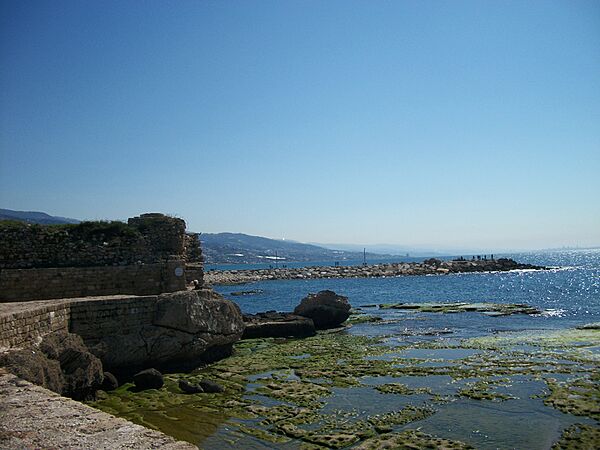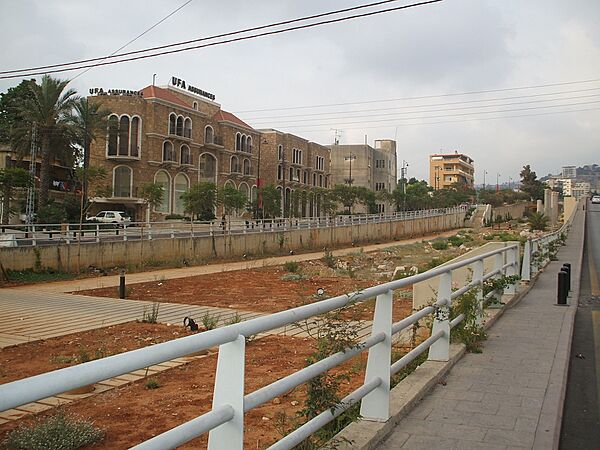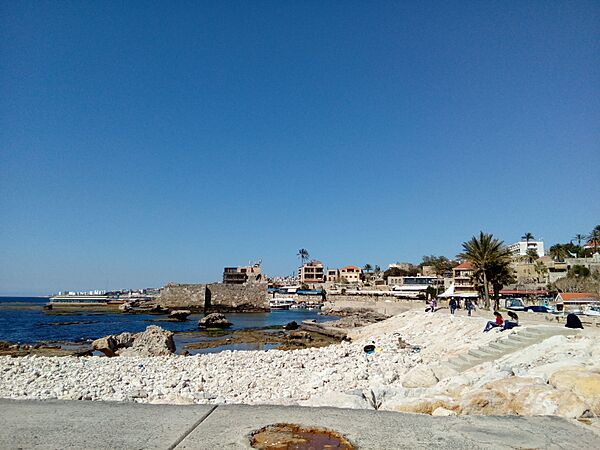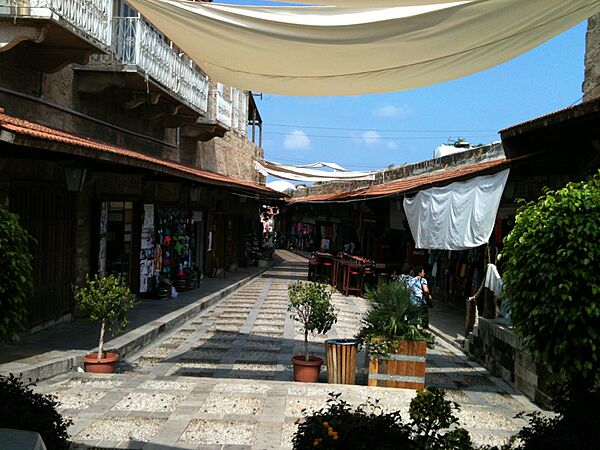Byblos facts for kids
Quick facts for kids
Byblos
جُبَيْل
Jebeil
|
|
|---|---|
|
City
|
|

Byblos Old Town
|
|
| Country | Lebanon |
| Governorate | Keserwan-Jbeil |
| District | Byblos |
| Area | |
| • City | 4.16 km2 (1.61 sq mi) |
| • Metro | 17 km2 (7 sq mi) |
| Population | |
| • City | 40,000 |
| • Metro | 100,000 |
| Time zone | UTC+2 (EET) |
| • Summer (DST) | UTC+3 (EEST) |
| Dialing code | +961 |
| UNESCO World Heritage Site | |
| Criteria | Cultural: iii, iv, vi |
| Inscription | 1984 (8th Session) |
Byblos (pronounced BIB-loss) is an ancient city in Lebanon. It is also known as Jebeil or Jbeil. People first lived here around 8800 to 7000 BC. It has been continuously lived in since 5000 BC. This makes Byblos one of the oldest cities in the world.
Over time, many different cultures have influenced Byblos. These include the ancient Egyptians, Phoenicians, Romans, and Ottomans. The city became a UNESCO World Heritage Site in 1984.
An important invention happened in ancient Byblos. The Phoenician alphabet was created here. This alphabet is believed to be the ancestor of the Greek, Latin, and many other Western alphabets.
Contents
What's in a Name?
The name Byblos comes from the Greek word for the city. The Greeks called it Byblos because it was a major place for importing papyrus from Ancient Egypt. Papyrus was a material like paper. The English word "Bible" actually comes from the Greek name of this city.
The city's older names were Gebal or Gubla. These names meant something like "Well of the God." Today, its Arabic name is Jubayl or Jbeil. This name is related to the old ones. During the Crusades, Westerners called it Gibelet.
A Look Back in Time
Byblos is about 42 kilometers (26 miles) north of Beirut. It is a very interesting place for archaeologists. Many layers of old settlements are found here. This shows how people lived for thousands of years.
Archaeologists like Ernest Renan and Maurice Dunand have studied Byblos. They found evidence that the city has always been in the same spot.
Ancient stories say that Byblos was the first city built in Phoenicia. It was supposedly founded by a god named Cronus. Around 3000 BC, Byblos started to become a real town. This was when the Canaanite civilization began to grow.
Early Settlements
People lived in Byblos during the Neolithic and Chalcolithic periods. These are very early times in human history. Archaeologists found remains of buildings and tools from these periods. They also found ancient pottery and burial sites.
The earliest settlement was around 8800 to 7000 BC. It was located near the sea, with good soil and a safe place for boats. Later settlements showed more advanced pottery and tools. They even found some early copper objects.
Byblos and Egypt
Byblos was very important to Ancient Egypt. During the Old and Middle Kingdoms of Egypt, Byblos was almost like an Egyptian colony. The Egyptians used timber from Byblos for their ships and buildings. Some Egyptian artifacts have been found in Byblos.
The rulers of Byblos kept strong ties with the Egyptian pharaohs. Around 1350 BC, letters from the ruler of Byblos, Rib-Hadda, were sent to the Egyptian government. These letters asked for military help.
After the New Kingdom of Egypt declined, Byblos became a leading city in Phoenicia.
The Phoenician Alphabet
One of the most important things from this period is the Phoenician alphabet. It had 22 characters. This alphabet was found on royal inscriptions in Byblos, dating back to 1200–1000 BC. The Phoenician merchants helped spread this alphabet through their trade routes. It traveled to North Africa and Europe.
Later Periods
Byblos was later part of the Assyrian and Persian empires. It became a vassal kingdom, meaning it was controlled by these larger empires.
When Alexander the Great arrived in 332 BC, the Greek influence began. Coins were used, and trade with other Mediterranean countries continued.
During the Roman period, the city was rebuilt. It was a center for the worship of a god named Adonis. A small but impressive theatre was built around 218 AD.
Crusaders and Beyond
In the 12th and 13th centuries, Byblos was part of the Crusader states. It was known as Gibelet. The Genoese Embriaco family ruled it. They built the Byblos Castle, which was an important military base.
The city was captured by Saladin in 1187. It was later taken back by the Crusaders. Then, in 1266, it was conquered by Baibars. The Embriaco family held onto it until around 1300.
From 1516 until 1918, Byblos was part of the Ottoman Empire. After that, it was under French rule until Lebanon became independent in 1943.
Who Lives in Byblos?
Most people in Byblos are Christians, mainly Maronites. There are also smaller groups of Armenian Apostolic, Greek Orthodox, and Greek Catholics. A small number of Shi`i Muslims also live there.
Learning in Byblos
Byblos is home to the professional schools of the Lebanese American University (LAU). The LAU Byblos Campus has schools for medicine, engineering, architecture, and pharmacy.
Visiting Byblos
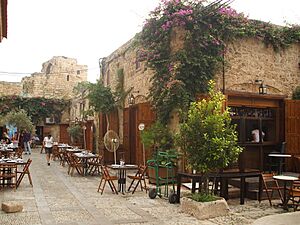
Byblos is a popular place for tourists. It has an ancient port, old ruins from different periods, and sandy beaches. The mountains around it add to its beauty.
The city is famous for its fish restaurants, outdoor bars, and cafes. Yachts still sail into its harbor today. Byblos was named the "Arab Tour Capital" in 2016. It was also chosen as the second best city in the Middle East by Condé Nast Traveler in 2012. The World Tourism Organization called it the best Arab tourist city in 2013.
Main Historic Sites
- Ain el-Malik or King's Spring: This is a deep cave with spiral stairs. It used to provide water for the city.
- The L-shaped Temple: Built around 2700 BC.
- The Temple of the Obelisks: This temple was originally built between 1600–1200 BC. It was moved by archaeologists. Many small obelisks were found here, used as religious offerings.
- The Royal Necropolis: This area has tombs of the Byblos kings from the second millennium BC. King Ahiram's tomb is here.
- The Roman Theater: Built around 218 AD.
Other Interesting Buildings
- Byblos Wax Museum: This museum shows wax figures of people from Phoenician times to today.
- Byblos Fossil Museum: Here you can see fossilized fish, sharks, and other sea creatures. Some are millions of years old.
- Medieval City Wall: The old part of Byblos is surrounded by walls.
- Byblos Castle: Built by the Crusaders in the 12th century. It is near the port.
- St John the Baptist Church: Work on this church started in 1115 during the Crusades.
- Sultan Abduljid Mosque: This old mosque dates back to the Mamluk period.
- Historic Quarter and Souks: An old market area in the historic city.
- Byblos International Festival: A summer music festival held every year in the historic quarter.
- Aram Bezikian Museum: A museum dedicated to remembering the Armenian Genocide.
Famous People from Byblos
- Majdi Allawi (born 1970), a Maronite priest.
- Jihad Azour (born 1966), an economist.
Sister Cities
Byblos is twinned with these cities:
Images for kids
See also
 In Spanish: Biblos para niños
In Spanish: Biblos para niños



